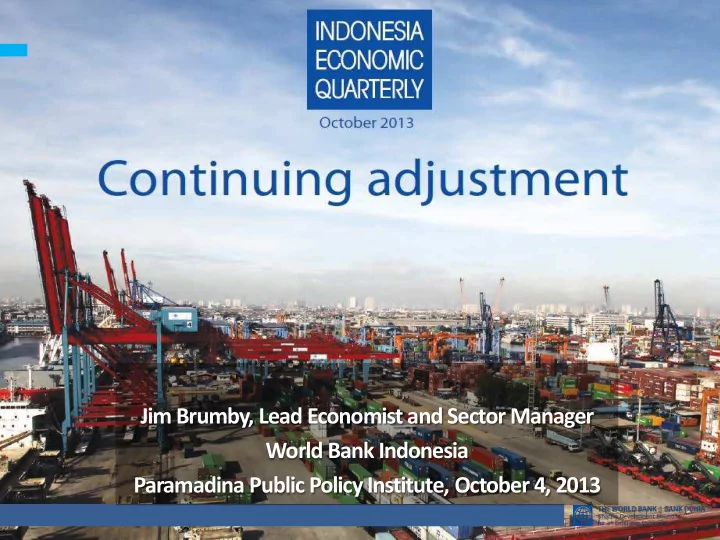

Jim Brumby, Lead Economist and Sector Manager World Bank Indonesia Paramadina Public Policy Institute, October 4, 2013
OCTOBER 2013 IEQ LAUNCH PRESENTATION More subdued growth outlook, resulting from two major shocks to the economy and ongoing adjustments Developments in Q3 show adjustments are well underway but highlight Indonesia’s macro vulnerabilities The role of good policies in this time of continuing adjustment
FIRST SHOCK: TRADE SHOCK, SINCE 2011… Quarterly merchandise trade balance, USD billion 12 10 8 6 4 2 0 -2 Source: BI
…AS TERMS OF TRADE HAVE WEAKENED US Dollar price index, 2000 average = 100 600 500 Brent crude oil 400 300 Indonesia’s major export commodities 200 100 0 -100 Jan-00 Jan-03 Jan-06 Jan-09 Jan-12 Source: World Bank
PRESSURING THE OVERALL CURRENT ACCOUNT Goods trade balance Services trade balance USD billion Income balance Current transfers 15 Current account balance 10 5 0 -5 -10 -15 Jun-07 Jun-08 Jun-09 Jun-10 Jun-11 Jun-12 Jun-13 Source: BI
SECOND SHOCK: FINANCING COSTS Yield, percent Emerging market sovereign USD bonds (EMBIG) 8 Indonesia sovereign USD bonds (EMBIG sub-index) 7 6 5 4 3 2 1 10-year US Treasury note 0 Sep-09 Apr-10 Nov-10 Jun-11 Jan-12 Aug-12 Mar-13 Source: JP Morgan
OCTOBER 2013 IEQ LAUNCH PRESENTATION More subdued growth outlook, resulting from two major shocks to the economy and ongoing adjustments Developments in Q3 show adjustments are well underway but highlight Indonesia’s macro vulnerabilities The role of good policies in this time of continuing adjustment
CURRENCY: RUPIAH ADJUSTING Index, 2010 average = 100 110 USD/IDR Inflation-adjusted 105 Trade-weighted trade-weighted 100 95 90 85 80 75 70 Sep-07 Sep-08 Sep-09 Sep-10 Sep-11 Sep-12 Sep-13 Source: World Bank
MONETARY CONDITIONS: TIGHTENING Percent, year-on-year BI Overnight deposit facility rate 10 200 New loan approvals (RHS) 150 8 100 6 50 4 0 FASBI rate 2 -50 0 -100 Jan-06 Dec-07 Dec-09 Dec-11 Source: BI
DOMESTIC DEMAND: SOFTENING Growth yoy, percent 9 100 8 80 Real domestic 7 60 demand 6 40 5 20 4 0 3 -20 Imports (US 2 Dollar, RHS) -40 1 0 -60 Jun-05 Oct-06 Feb-08 Jul-09 Nov-10 Apr-12 Source: BPS; World Bank staff calculations
INVESTMENT SLOWING DOWN Real fixed investment growth, percent 16 Building Foreign machinery & equip Foreign transportation Other Total 12 8 4 0 -4 Jun-11 Dec-11 Jun-12 Dec-12 Jun-13 Source: World Bank
REPEATED DOWNWARD REVISIONS Average of analysts’ real GDP growth forecasts 6.4 2014 6.2 6.0 5.8 2013 5.6 5.4 Source: Consensus Economics
OUTLOOK: MORE ADJUSTMENT TO COME… October IEQ Previous (July) 2011 2012 2013p 2014p 2013p 2014p Real GDP (% change) 6.5 6.2 5.6 5.3 5.9 6.2 Consumer price (% change) 5.4 4.3 7.3 6.7 7.2 6.7 index Current account (% GDP) 0.2 -2.8 -3.4 -2.6 -2.7 -2.1 deficit Major trading (% change) 3.6 3.4 3.4 3.9 3.4 4.0 partner GDP Source: BI; BPS; Ministry of Finance; World Bank staff projections
…BUT PERSPECTIVE, PLEASE Real GDP growth, percent 8 Indonesia 6 4 2 Major trading partners 0 -2 -4 -6 Mar-07 Mar-08 Mar-09 Mar-10 Mar-11 Mar-12 Mar-13 Source: World Bank
OCTOBER 2013 IEQ LAUNCH PRESENTATION More subdued growth outlook, resulting from two major shocks to the economy and ongoing adjustments Developments in Q3 show adjustments are well underway but highlight Indonesia’s macro vulnerabilities The role of good policies in this time of continuing adjustment
THREE R’S FOR POLICY Responding, to facilitate more near-term adjustment: Monetary and fiscal policy coordination Exchange rate flexibility Reducing uncertainty: Contingency planning Communication Refocusing policies to lift sustainable growth rate: August package: follow through “Quick wins” for competitiveness Fiscal sector: energy subsidies, infrastructure spending, social protection
AUGUST PACKAGE: IMPLEMENTATION IS KEY Relieve external balance pressures • Exports: tax relief for labor-intensive exporters • Investment: DNI; “de-bottlenecking” Reduce inflation pressures • Food imports: move to price-based restrictions Support employment • Bounded zones • Tax relief for qualifying firms in labor-intensive sectors • Minimum wages
MORE MEASURES TO LIFT COMPETITIVENESS Boost from weaker Rupiah provides an opportunity… …but will be wasted without a supply response “Quick wins” in trade facilitation can help Average container dwell time at Tanjung Priok, days 10.5 9.5 8.5 7.5 6.5 5.5 4.5 Jan-11 Jul-11 Jan-12 Jul-12 Jan-13 Jul-13 Source: Jakarta International Container Terminal (JICT)
COSTS AND RISKS FROM ENERGY SUBSIDIES Energy subsidy costs – baseline and with 10 percent IDR depreciation/oil price increase IDR trillion 400 350 300 250 200 Energy subsidies (Baseline) 150 Energy subsidies (10% IDR depreciation) 100 Energy subsidies (10% Oil price increase) 50 0 2009 2010 2011 2012 2013* 2014* Note: *World Bank projections Source: World Bank staff calculations
REDIRECTING SPENDING: THE OPPORTUNITY Spending on fuel subsidies and infrastructure, percent of GDP Fuel subsidy cost Total infrastructure spending (government, SOE and private) 7 6 5 4 3 2 1 0 2004 2005 2006 2007 2008 2009 2010 2011 2012 2013* 2014* *World Bank projections Source: Ministry of Finance; World Bank
MORE INFRASTRUCTURE STOCK, HIGHER INCOME 2011 per capita income – actual, and following higher annual infrastructure growth rate increases (USD) 4,500 4,000 648 180 3,500 3,000 2,500 2,000 3,471 1,500 1,000 500 - Actual 5 percent 10 percent Source: World Bank staff calculations
BREAKING INTO INFRASTRUCTURE CYCLE ADDRESS THE PERSISTENT INFRASTRUCTURE GAP SUPPORT REALLOCATE EXTERNAL SPENDING BALANCES OVER TOWARDS THE MEDIUM- INFRASTRUCTURE TERM • Improve domestic and external • Offset the rise in financing costs competitiveness • Enhance sustainable growth Potential to re-orientate • import-intensity of spending • Enhance FDI potential (and provide more stable financing)
MAIN MESSAGES Indonesia faces greater constraints: trade shock, global liquidity The economy and policy settings are adjusting: Base case outlook for growth moderation and gradually narrowing current account deficit But external uncertainties still elevated and adjustment phase carries risks Critical continued role for policy – 3 R’s: R esponding, to facilitate more near-term adjustment R educing uncertainty: contingency planning and communication to support confidence R efocusing policy efforts on lifting competitiveness and the sustainable growth rate • August policy package implementation • Additional “quick wins”, e.g. trade facilitation • Continuing progress on fiscal sector reforms
Recommend
More recommend